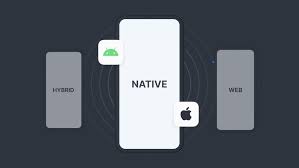
I. Introduction
The world of mobile development is in constant evolution, shaped by rapid technological advances and a growing demand from users. The selection of a programming language plays a central and strategic role in crafting high-performing and functional mobile applications. It's a crucial decision for developers and businesses focused on app development, directly influencing the quality, development speed, and user experience of the final application.
In this article, delve deep into the indispensable programming languages for mobile development, shedding light on their advantages, drawbacks, and relevance in an ever-evolving industry. We'll also analyze emerging trends and promising technologies that will shape the future of mobile development. Get ready to embark on an informative journey to enlighten your choices in the dynamic world of mobile development.
II. Programming Languages Tailored for Mobile Platforms"

2.1 Java: Unleashing the Power of Versatility
Java demeure indiscutablement un choix de prédilection pour le développement d’applications Android, en étant le langage dominant du développement mobile depuis de nombreuses années. Voici une présentation approfondie de ses caractéristiques et de son utilité dans ce contexte.
Advantages of Using Java in Mobile Development:
- Versatility: Java is a versatile language enabling the development of various mobile applications, from games to complex enterprise solutions.
- Vast Ecosystem: Boasting an extensive standard library, Java offers a plethora of frameworks and tools, simplifying mobile development.
- Portability: Java code can run on any device with a Java Virtual Machine (JVM), ensuring Android application portability.
- Active Community: Java thrives with an engaged developer community, ready to share knowledge, best practices, and solutions.
Drawbacks or Limitations of Java in Mobile Context:
- Performance: While Java's performance has significantly improved, some developers argue that other languages like native C/C++ offer better performance in certain situations.
- Memory Consumption: Java is reputed to consume more memory than some other languages, a critical factor for resource-minimal applications.
Tips for Optimizing Java Usage in Mobile Development:
- Code Optimization: Writing clean, efficient, and well-organized code significantly enhances mobile app performance. Avoid redundancies, optimize loops, and reduce unnecessary resource usage.
- Monitor Memory Consumption: Use profiling tools to monitor Java application memory consumption and optimize code to reduce excessive memory usage.
- Effective Exception Handling: Proper exception handling can improve application reliability. Identify areas where exceptions can be handled appropriately and implement suitable recovery mechanisms.
Java remains a robust and viable option for Android mobile app development. However, considering the specific requirements of each project is crucial for choosing a language that optimizes both user experience and application performance.
2.2 Swift: Elevating iOS Development
Swift, développé par Apple, s’est imposé comme le langage de choix pour le développement iOS. Sa popularité croissante est due à plusieurs avantages qui en font un langage incontournable dans le monde du développement mobile.
Advantages of Swift in Mobile Development:
- Exceptional Performance: Swift is designed to deliver optimal performance, often surpassing Objective-C in execution speed and efficiency.
- Enhanced Security: Equipped with built-in features to prevent common errors, Swift ensures safer and more reliable iOS applications.
- Clear and Concise Syntax: Swift's intuitive, streamlined, and readable syntax simplifies code writing and comprehension, fostering developer productivity.
- Ease of Maintenance: Thanks to its modern design and clear syntax, maintaining Swift applications is easier, reducing time and associated costs.
- Interop with Objective-C: Swift seamlessly coexists with existing Objective-C code, allowing a smooth transition to Swift while utilizing Objective-C libraries and frameworks.
Challenges or Potential Issues with Swift:
- Constant Evolution: Swift is a continuously evolving language with regular version updates, requiring ongoing adaptation and vigilance to stay current.
- Resource and Documentation: While the Swift ecosystem is expanding, it may sometimes lack resources and documentation compared to more established languages.
Tips to Maximize Swift Usage in Mobile Development:
- Continuous Learning: Invest time in continuous learning of Swift, staying updated on language updates and developments.
- Code Optimization: Embrace coding best practices, such as judicious use of optionals, to ensure clean and optimized code.
- Community Engagement: Get involved in the Swift community by contributing to open-source projects, participating in forums, and following industry experts.
- Development Tool Usage: Familiarize yourself with Swift-specific development tools like Xcode and its features to fully leverage the language.
Swift is undoubtedly a strong choice for iOS development, offering substantial benefits in terms of performance, security, and productivity. However, staying informed about language developments and actively engaging in the Swift community are essential for fully realizing the potential of this promising language.
2.3 Kotlin: Rising Star in Android Development
Kotlin, a rising star in the Android development universe, is quickly gaining popularity as a compelling alternative to Java. Explore the distinctive features of Kotlin and the reasons behind its becoming a convincing choice.
In-Depth Exploration of Kotlin and Its Growing Adoption in Android Development:
- History and Evolution: Uncover the origin of Kotlin, its creators, and how it evolved to become a language officially supported by Google for Android development.
- Key Features: Explore Kotlin's key features such as type safety, function extensions, and lambda expressions that simplify and accelerate the development process.
Comparison Between Kotlin and Java, Highlighting Kotlin's Advantages:
- Code Conciseness and Readability: Examine examples of Kotlin and Java code to illustrate how Kotlin enables writing more concise and readable code, facilitating maintenance and understanding.
- Enhanced Security: Spotlight Kotlin's security mechanisms, including type safety, significantly reducing errors and application crashes.
- Interop with Java: Explain how Kotlin can coexist and interact seamlessly with existing Java code, offering a smooth transition and allowing developers to adopt Kotlin gradually.
Examining Why Kotlin is Considered an Attractive Alternative to Java:
- Adoption by Major Companies: Showcase real cases of major companies adopting Kotlin and sharing positive experiences, demonstrating Kotlin's credibility and reliability in professional environments.
- Increased Productivity: Provide tips for improving productivity with Kotlin, such as using extension functions to simplify recurring tasks and reducing boilerplate code.
- Active and Growing Community: Encourage developers to join Kotlin communities, participate in events, and follow specialized blogs to stay updated, exchange ideas, and leverage best practices.
Kotlin has established itself as a smart choice for Android development due to its conciseness, enhanced security, and increased productivity. Developers are encouraged to explore and experiment with this language to maximize their efficiency and stay at the forefront of innovation in the ever-evolving world of mobile development.
III. Langages et frameworks multiplateformes pour le développement Mobile

3.1 JavaScript (with React Native): Elevate Your Mobile Development Game
JavaScript, coupled with React Native, takes the lead in cross-platform mobile development technologies. Let's dive into the details of this powerful combination, exploring its advantages, limitations, and crucial considerations in choosing this approach.
In-Depth Presentation of React Native, Illuminating its Use for Cross-Platform Development:
- Origin and Evolution: Trace the evolution of React Native from its inception as an internal project at Facebook to becoming one of the most popular cross-platform frameworks.
- Fundamental Operation: Explore key concepts of React Native such as components, virtualized rendering, and data flow—integral elements contributing to its efficiency and rapid development.
Advantages of Using React Native for Mobile Development:
- Code Reusability: Highlight the substantial time and effort saved through code reuse between iOS and Android platforms, fostering the creation of cohesive applications.
- Competitive Performance: Emphasize React Native's competitive performance, closely resembling native apps due to native code compilation and hot reloading, significantly improving development efficiency.
- Extensive Component Ecosystem: Showcase the plethora of pre-built components and modules available in the React Native community, enabling swift development and integration of complex features.
Limitations and Important Considerations when Choosing React Native:
- Performance Tailored to Needs: Explain that while React Native delivers high performance in many scenarios, it's crucial to identify cases where native development may be more suitable to ensure optimal performance.
- Native Modules for Advanced Features: Specify that using native modules may be necessary for specific features requiring maximum performance and how to effectively manage this integration.
- Update Management: Reinforce the importance of regularly tracking React Native updates and ensuring code compatibility with the latest versions to benefit from performance and security improvements.
JavaScript with React Native offers a flexible and potent solution for cross-platform mobile development. It's essential for developers to understand the advantages and limitations of this approach to make informed choices, optimize performance, and ensure the success of their mobile projects.
3.2 Dart (with Flutter): Unleash the Power of Seamless Cross-Platform Development
Dart, paired with Flutter, stands out as a prime solution for cross-platform mobile development. In this section, let's delve deep into this association, highlighting the major benefits and potential challenges.
In-Depth Presentation of Flutter, Emphasizing its Use for Cross-Platform Development:
- Origin and Evolution: Explore Flutter's evolution from its inception at Google, showcasing how it became one of the most favored frameworks for cross-platform app development.
- Architecture and Operation: Break down Flutter's widget-based architecture, illustrating how it simplifies the creation of dynamic and responsive user interfaces.
Advantages of Using Flutter in Mobile Development:
- Code Reusability: Emphasize complete code reuse between iOS and Android platforms, resulting in substantial time and effort savings.
- High Performance: Highlight Flutter's high performance through direct rendering and native code compilation, ensuring a smooth and responsive user experience.
- Attractive and Customizable Design: Spotlight Flutter's flexibility for creating custom and aesthetically appealing designs, offering a unique user experience.
Discussion on Potential Limitations or Challenges with Flutter:
- Application Size: Analyze challenges related to the potentially larger size of Flutter app installation files and provide tips to optimize size without compromising performance.
- Interop with Native Features: Highlight challenges in integrating certain native features into a Flutter app and propose approaches to resolve these issues, such as using channels for communication between Flutter and native code.
Dart with Flutter offers a powerful and modern solution for cross-platform mobile development. Deep understanding of the advantages and challenges of this technology is crucial for developers to make informed choices, optimize their applications, and ensure the success of their mobile projects.
3.3 Xamarin (with C#): Crafting Unified Experiences Across Platforms
In this section, we'll dive deep into the realm of Xamarin, coupled with the C# language. We'll explore this combination in detail, shedding light on its major advantages and considerations when choosing it for cross-platform development.
In-Depth Exploration of Xamarin and its Use in Cross-Platform Development:
- History and Evolution: Take a journey through the history of Xamarin, from its beginnings as MonoTouch and Mono for Android to its acquisition by Microsoft, highlighting its evolution and gradual integration into the Microsoft ecosystem.
- Operation and Architecture: Explain in detail how Xamarin operates, emphasizing its approach based on sharing business (logic) code while allowing platform-specific user interfaces through separate user interface files.
Advantages of Using Xamarin for Mobile Development:
- Extensive Code Reusability: Stress the ability to share up to 95% of code between platforms while offering the flexibility to customize features according to each platform's specifics.
- Near-Native Performance: Highlight Xamarin's performance approaching native levels, thanks to Ahead Of Time (AOT) and Just In Time (JIT) compilation, ensuring a fast and smooth user experience.
- Direct Access to Native Features: Showcase complete access to device features through direct integration with native APIs, enabling easy incorporation of platform-specific functionalities.
Limitations and Points to Consider when Choosing Xamarin:
- Cost Consideration: Address the high initial cost of Xamarin, including paid licenses, and suggest free alternatives for budget-conscious projects, such as Xamarin Community Edition or open-source frameworks based on C#.
- Platform-Specific UIs: Explain in detail that certain parts of the user interface need to be specifically designed for each platform, emphasizing the importance of understanding best practices for creating a consistent user experience.
Tips for Maximizing Xamarin Usage in Cross-Platform Development:
- Mastering C#: Encourage developers to master the C# language to fully exploit Xamarin's features, showcasing the richness of the .NET platform.
- Learning Platform Specifics: Suggest studying the specifics of Android and iOS in detail to best customize user interfaces and leverage platform-specific features.
- Community Engagement: Invite developers to join Xamarin discussion groups, forums, and community events to exchange experiences, solve problems, and stay updated with the latest developments.
Xamarin with C# offers a robust and modern solution for cross-platform mobile development. In-depth understanding of the benefits, challenges, and tips for optimal usage allows developers to make wise choices, optimize their applications, and ensure the success of their mobile projects.
IV. The Future of Mobile Development: Innovate and Thrive

4.1 Emerging Trends:
In this section, let's embark on a journey into the current and future trends of mobile development, rapidly reshaping the technological landscape. Peer into the future to discover innovations that will redefine how we conceive and use mobile applications.
Exploring Current and Future Trends in Mobile Development:
- 5G and Edge Computing: Uncover how the fusion of 5G technology and Edge Computing is revolutionizing mobile application performance. 5G provides ultra-fast connections, while Edge Computing enables real-time data processing, opening new possibilities for data-intensive applications.
Tip: Optimize your applications to fully leverage 5G by reducing latency and offering immersive experiences. - Artificial Intelligence and Machine Learning: Delve into the impact of AI and ML on mobile app development. From intelligent chatbots to personalized experiences, AI offers immense opportunities to enhance performance and user interaction.
Tip: Integrate AI features into your apps to boost user engagement and personalize their experience. - Internet of Things (IoT): Immerse yourself in the growing integration of IoT devices with mobile applications. IoT apps offer connected functionalities and unique user experiences, from smart homes to wearables.
Tip: When developing IoT apps, ensure excellent data management and security for a smooth and secure experience. - Augmented Reality (AR) and Virtual Reality (VR): Discover how AR and VR are transforming mobile applications. These technologies provide immersive experiences in various domains such as online shopping, education, and entertainment.
Tip: Experiment with AR and VR to create unique and captivating applications that stand out in the market.
Discussion on Innovative Developments Shaping the Future:
- Conversational Applications: Explore the shift towards conversational user interfaces with chatbots and virtual assistants. These apps offer a more natural and streamlined interaction for users.
Tip: Design intelligent and responsive chatbots that proactively and efficiently meet user needs. - Component-Based Development: Discuss the trend towards component-based development. This approach promotes code reuse, accelerating development and enhancing application maintainability.
Tip: Adopt a modular approach in development, encouraging the creation of reusable component libraries for efficiency. - Enhanced Security: Highlight the increasing importance of mobile app security. With the rise of cyberattacks, developers must prioritize security from the design phase.
Tip: Conduct regular security tests and use advanced security tools to detect and address vulnerabilities.
The future of mobile development promises excitement, with ever-evolving technologies. By staying informed about these trends and anticipating innovative developments, developers can prepare mobile apps that meet future needs, providing exceptional and revolutionary user experiences.
4.2 Emerging Languages and Frameworks:
In this section, let's explore emerging languages and frameworks that could play a crucial role in the future of mobile development. Dive into these new technologies and analyze their potential and relevance in the mobile development landscape.
Présentation des langages et des frameworks émergents
- Dart and Flutter: Shed light on Dart, an open-source programming language developed by Google, powering the rising multi-platform framework, Flutter. Explore Flutter's development ease and impressive performance, making it a technology of choice for mobile developers.
Tip: Encourage developers to explore Flutter and learn Dart for efficient cross-platform app development. - Kotlin Multiplatform Mobile (KMM): Present Kotlin Multiplatform Mobile, an emerging language based on Kotlin gaining popularity for efficiently sharing code between iOS and Android platforms. Explore how KMM simplifies development, reduces code duplication, and improves development team productivity.
Tip: Promote learning Kotlin to enable developers to fully leverage Kotlin Multiplatform Mobile and maximize code reuse. - React Native with TypeScript: Emphasize the use of TypeScript with React Native, providing static typing and improved code maintenance. Analyze how this combination enhances application robustness and facilitates collaboration within development teams.
Tip: Highlight the benefits of more reliable and well-documented code with TypeScript, improving project quality and maintainability.
Analysis of their Potential and Relevance:
- Scalability and Cost Reduction: Discuss the ability of these emerging languages and frameworks to reduce development costs by enabling code reuse across different platforms. Explore how this can contribute to better project scalability.
Tip: Encourage teams to develop effective code-sharing strategies for substantial long-term savings. - Performance and User Experience: Analyze how these new technologies aim to offer near-native performance and optimized user experiences. Highlight how this meets the expectations of modern users.
Tip: Emphasize the importance of performance optimization to ensure a smooth and fast user experience, a key element of customer satisfaction. - Adaptability to Future Needs: Evaluate the flexibility of these emerging languages and frameworks to adapt to future changes in mobile technology. Explore how they can remain relevant and address upcoming challenges.
Tip: Encourage the adoption of an agile approach in development, allowing quick adaptation to market and technology changes.
The future of mobile development lies in the adoption of emerging languages and frameworks. By understanding their potential and relevance, developers can make informed decisions, choosing the best technologies for their projects, ensuring high-performance, scalable, and future-ready mobile applications.
Conclusion
In this exploration of the vast and dynamic world of mobile development, we've highlighted several indispensable programming languages, each with its own strengths and specificities.
Summary of Key Programming Languages:
- Java: Explored the power and versatility of Java, a dominant language for Android development. Its advantages in terms of portability and a large community make it a solid choice for many projects.
- Swift: Dived into Swift, a modern language designed specifically for iOS development. With its expressive syntax and performance, Swift offers an exceptional development experience.
- Kotlin: Discovered Kotlin, continually growing in Android development. Its modern features and compatibility with Java make it an attractive alternative for developers.
- Dart: Explored Dart, the backbone of Flutter, a rising multi-platform framework. Its ease of learning and efficiency make it a promising choice.
- JavaScript (with React Native): Highlighted React Native, based on JavaScript, enabling the development of cross-platform apps with a single codebase. Its growing popularity and performance make it a major player.
- Dart (with Flutter): Examined Flutter, powered by Dart, offering an efficient and visually appealing cross-platform development experience. Its complete code reuse and near-native performance are significant advantages.
Recommendations for Developers:
It is crucial for developers to choose the right language based on the specific needs of their project and current trends. Here are some key recommendations:
- Analyze Project Requirements: Carefully assess the project's needs and goals, along with specific required features. Some languages are better suited to certain types of applications.
- Consider Community and Documentation: Consider the size and vitality of the community surrounding each language. A large community can provide excellent support and solutions to common problems.
- Anticipate Scalability: Envisage the possibility of evolving and expanding your application in the future. Choose a language that facilitates this evolution without causing major complications.
- Stay Updated with Trends: Stay informed about current trends in mobile development. Emerging languages can offer new opportunities and improve the efficiency of your development.
Keeping these recommendations in mind, developers can make informed decisions when choosing the programming language for their project. Choosing the right language is a crucial step toward creating successful mobile applications that meet the specific needs of users and remain relevant in a constantly evolving technological landscape.
Need personalized advice for your mobile development project? Our experts at Nxtya are ready to assist you. Feel free to contact us to schedule a demonstration and discuss your projects in detail. Benefit from our expertise to create innovative and high-performance mobile applications.


